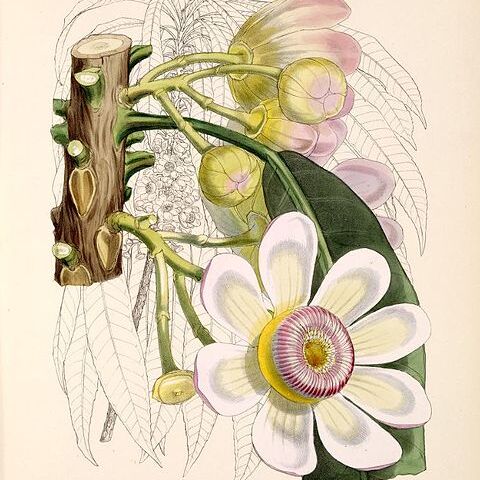Trees to about 20 m. tall, with stout straight-trunks, branching infrequently; leafy twigs rather stout. Leaves congested seasonally toward the tips of the branches, usually very large and with proportionally short and stout petioles, the blade elliptic-oblanceolate, up to about 10 dm. long and 2 dm. broad, rather abruptly and acutely acuminate, narrowly cuneate and more or less decurrent to the petiole, coarsely to rather obscurely undulate-serrate, membranaceous, glabrous; petiole 2-9 cm. long. Flowers mostly densely cauliflorous beneath the terminal cluster of leaves; peduncle stout, usually about 6 cm. long, corymbosely several-flowered; hypanthium turbinate, about 1.5 cm. long and broad at anthesis; calyx reduced to a more or less obscurely 4-lobed ring 1.5-2.0 cm. in diameter, densely puberulent-papillate; petals 6-12, more or less unequal, oblong-obovate, white, usually yellowish at the base and more or less tinged with pink or lavender toward the tip, 4-7 cm. long, minutely papillate. Mature fruits depressed-globose, up to about 8 cm. broad and 6 cm. long, the opercular region about one third as broad, very fleshy, the pericarp about 5-10 mm. thick.
More
An evergreen tree. It grows 15 m high. The wood when cut produces a bad smell. The leaves are simple and deep green. They are 128 cm long and broadly sword shaped. They are deeply veined. The flowers are creamy-white to pale pink and 15 cm across. They have 7-9 wavy petals. They have a sweet smell. The fruit are like berries and 10 cm across. They are orange. The pulp is edible. It has seeds buried in it.
A tropical plant. It is native to Central and South America. It grows in rainforests and swampy woodlands. It can tolerate some drought. It grows up to 1,000 m altitude. It suits hardiness zones 10-12. In Townsville Anderson BG.
More
Humid woodlands and rainforest, often in swampy soils. Found on gently sloping, sunny hills.


